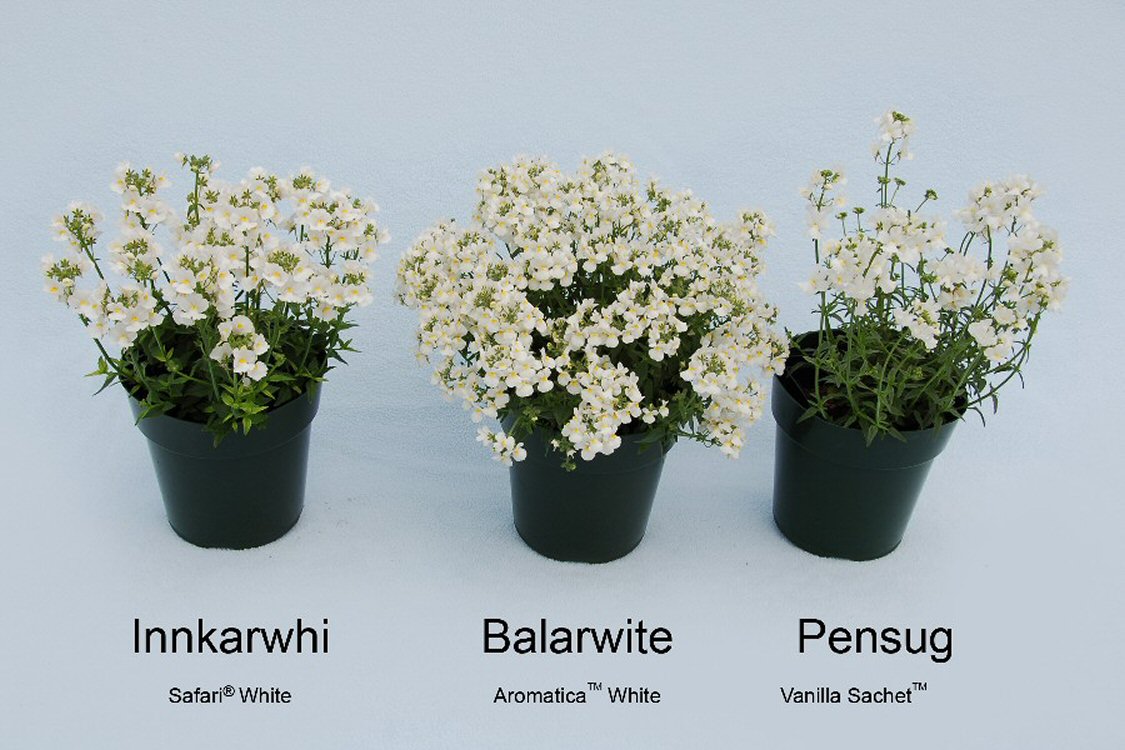Innkarwhi
| Denomination: | 'Innkarwhi' |
|---|---|
| Trade name: | Safari White |
| Botanical Name: | Nemesia |
| Applicant/Holder: |
InnovaPlant Zierpflanzen GmbH & Co. KG Postfach 113 D-55454 Gensingen Germany |
| Breeder: |
Silvia Hofmann, InnovaPlant Zierpflanzen GmbH & Co. KG, Gensingen, Germany |
| Agent in Canada: |
BioFlora Inc. 38723 Fingal Line R.R. #1 St. Thomas, Ontario N5P 3S5 Canada Tel: 519-317-7511 |
| Application Date: | 2006-02-23 |
| Application Number: | 06-5241 |
| Grant of Rights Date: | 2008-07-03 |
| Certificate Number: | 3245 |
| Date rights surrendered: | 2014-07-03 |
Variety Description
Varieties used for comparison: 'Pensug' (Vanilla Sachet) and 'Balarwite' (Aromatica White)
Summary: The plants of 'Innkarwhi' are moderately dense while they are dense to very dense for 'Balarwite'. The corolla width of 'Innkarwhi' is more narrow than 'Pensug' and wider than 'Balarwite'. 'Innkarwhi' has a wider leaf and a longer pedicel than the reference varieties. The lower lip of 'Innkarwhi' is wider with weaker reflexing than the reference varieties. 'Innkarwhi' has a lighter yellow palate than the reference varieties.
Description:
PLANT: very erect to erect growth habit, medium density, medium branching
STEM: thin to medium
LEAF BLADE: lanceolate, medium to dark green, serrate to dentate margin
PETIOLE: present
CALYX: dense
COROLLA SPUR: straight, equal in length to lower corolla lobe
COROLLA: uniform colour distribution, white on the upper and lower sides, very faint yellow markings at the base on the upper side of upper lobes, conspicuousness of markings is very weak
CENTRAL LOBES OF UPPER LIP OF COROLLA: weak margin undulation, absent or very weak reflexing
LATERAL LOBES OF UPPER LIP OF COROLLA: absent or weak reflexing
LOWER LIP OF COROLLA: white, medium to strong margin undulation, very weak reflexing
PALATE: yellow with yellow orange at the base, small to medium
Origin & Breeding History: 'Innkarwhi' originated from a cross conducted in the summer of 2001 in Gensingen, Germany. The female parent was an unnamed variety designated as N01 2-4 and the male parent was an unnamed variety designated as N01 4-3 tet 4. The new Nemesia variety was selected in the spring of 2002 for criteria based on flower colour, strong scent, compact growth habit and continuous flowering. Asexual reproduction by vegetative cuttings was first conducted in the spring of 2002 in Gensingen, Germany.
Tests & Trials: The PBR trials were conducted in a polyhouse during the spring of 2007 in St. Thomas, Ontario. The trials included a total of 15 plants of the candidate variety and reference variety. All plants were grown from rooted cuttings and transplanted into 10.5 cm pots on March 20, 2007. Observations and measurements were taken from 10 plants of each variety on May 14, 2007. All colour measurements were made using the 2001 Royal Horticultural Society (RHS) colour chart.
Comparison tables for 'Innkarwhi' with reference varieties 'Pensug' and 'Balarwite'
Plant height (cm)
| 'Innkarwhi' | 'Pensug' | 'Balarwite' | |
|---|---|---|---|
| mean | 20.2 | 23.7 | 19.2 |
| std. deviation | 1.19 | 1.92 | 1.08 |
Leaf width (cm)
| 'Innkarwhi' | 'Pensug' | 'Balarwite' | |
|---|---|---|---|
| mean | 12.1 | 9.2 | 10.5 |
| std. deviation | 1.20 | 1.75 | 2.01 |
Pedicel length (mm)
| 'Innkarwhi' | 'Pensug' | 'Balarwite' | |
|---|---|---|---|
| mean | 15.3 | 11.5 | 14.6 |
| std. deviation | 1.57 | 0.85 | 2.22 |
Corolla width (mm)
| 'Innkarwhi' | 'Pensug' | 'Balarwite' | |
|---|---|---|---|
| mean | 18.0 | 19.4 | 15.1 |
| std. deviation | 0.82 | 1.26 | 1.10 |
Lower lip of corolla width (mm)
| 'Innkarwhi' | 'Pensug' | 'Balarwite' | |
|---|---|---|---|
| mean | 15.5 | 14.3 | 10.3 |
| std. deviation | 0.85 | 2.50 | 1.06 |
Palate colour
| 'Innkarwhi' | 'Pensug' | 'Balarwite' | |
|---|---|---|---|
| RHS | 9A with 15A at the base | 9B-C | 9B |
Click on image for larger view

Nemesia: 'Innkarwhi' (left) with reference varieties 'Pensug' (centre) and 'Balarwite' (right)
Click on image for larger view

Nemesia: 'Innkarwhi' (left) with reference varieties 'Balarwite' (centre) and 'Pensug' (right)
- Date modified: